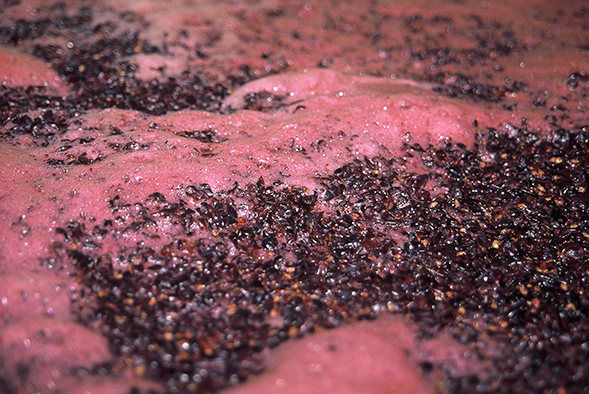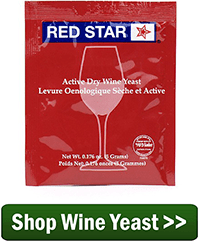 I started a batch of wine. When I added my yeast it did not get foamy but you could hear it working and see it bubbling. I’m wondering what could cause this or if you think there might be a problem with it.
I started a batch of wine. When I added my yeast it did not get foamy but you could hear it working and see it bubbling. I’m wondering what could cause this or if you think there might be a problem with it.
Thanks
Rick, Holly Springs, MS
—–
Hello Rick,
The fact that there is no foaming during the fermentation could be an indication that you have an issue. It never hurts to look over the Top 10 Reasons For Fermentation Failure and see if any of the reasons apply to your situation. These 10 reasons cover well over 95% of this issues we come across.
But it is much, much more likely that you do not have anything to worry about. The amount of foam does vary from one fermentation to the next, regardless of the amount of activity that is actually going on through the air-lock. In all likelihood you are simply being fooled by the foam – or lack of it.
There are several factors that can cause this variation in foaming during the fermentation. I’ll quickly go over the two big ones:
- The Fruit You Are Using: Proteins and other gelatinous materials that are in the fruit are the main components that cause a fermentation to foam. You have strawberries and peaches at the high end of the protein spectrum and apples and cranberries at the low end. This mean you can expect the foaming to vary based on the fruit you are fermenting.
- The Wine Yeast You Are Using: Some wine yeast can create a bit of foam. Red Star’s ‘Premier Classique’ is one of them. Then there are wine yeast that don’t foam much at all. Red Star’s ‘Cote des Blancs’ would be and example of this. These wine yeast have been bred to produce very little foam so as to not cause clean-up problems in a winery situation.

To really know how things are going with your wine’s fermentation you really should not depend on the amount of foam you see. As you can start to see, it really doesn’t mean that much. You need to rely on a wine hydrometer. By taking hydrometer readings during the wine’s fermentation, you can track how fast or how slow your wine is fermenting.
If you take a couple of hydrometer readings a couple of days apart and there is no change, then you know your wine is not fermenting. If the hydrometer readings are different, then you know you have progress and you don’t need to be concerned.
Just because there is no foaming during the fermentation doesn’t mean you have a problem. It is the wine hydrometer that has the final say as to what’s going on, so take your hydrometer readings, and don’t be fooled-by-the-foam.
Happy Wine Making,
Ed Kraus
—–
Ed Kraus is a 3rd generation home brewer/winemaker and has been an owner of E. C. Kraus since 1999. He has been helping individuals make better wine and beer for over 25 years.

Hi made Luna Rossa wine from a kit. I started fermenting at 75 degrees Fahrenheit and Specific Gravity 1.094, it did well fermenting. I Racked it after it got to 1.009 Specific Gravity (7 days) as directed. After racking, the wine would not go to .996 Specific Gravity. The lowest it would go was 1.000 Specific Gravity. The instructions said to wait till it went to .996 before continuing and to give it more time which I did. I waited an extra 8 days, but it stead at 1.000 SG. I left it a total of 15 days at 1.000 Specific Gravity. I then continued and added Metabisuiphite and Sorbate, and Chitosan Clarifier and Degassed the wine.
My question: What should I have done when it would not go lower the 1.000 Specific Gravity?
Might have been, might be an issue where your wine is containing to much CO2 and floating the hydrometer. It’s happened before. A botling hydrometer, (narrow range) is easier to read in the smaller section.
Vito, a good thing to do when you have a stubborn fermentation such as yours is to go over an article on our website called, "Top 10 Reasons For Fermentation Failure". It’s listed under the articles section of the website. This article would have helped you decide what to try in order to solve you problem. Beyond this, it never hurts to check you hydrometer in water to see that it is still accurate. On very rare occasions the paper in the hydrometer can slip giving you bad readings.It should read 1.000 in water.
Hi, I can hear my wine fizzle and there are some small bubbles, not allot. I did heat my yeast up too hot. I started it 3 days ago. Can I just add a second packet of yeast or should I just let it go as is. The water was not simmering but was heated. If I killed most if the yeast can I ferment it with what’s living? Is there such a thing as fermenting too slow and more yeast is needed?
Definitly add new yeast; it will not hurt it, and it will stop a bad ferment; 1 packet per 5 gal
Derek, your instincts are correct on this one. You do not want a slow fermentation from the very beginning. You’d like to see it take off ‘guns blazin’, so to speak, then taper off in its level of activity. It is perfectly okay to add a second pack of wine yeast. It will not hurt anything and may be a solution to any issue you may be having, but I would also like to invite you to take a look at, "Top 10 Reasons For Fermentation Failure", that is an article listed on our website at the following link: http://www.eckraus.com/wine-making-failure/
Hi, I am trying to make Pinot Grigio from Pinot grapes. The recipe I used called for high temperatures in fermenting. It started out with a Specific Gravity of 1.100. It only fermented for 1 1/2 days quite strongly and now is at a Specific Gravity of 1.000. I have read the Top 10 Reasons for Fermentation Failure and can’t decide what to do. I know there was high sugar to begin with, but I wonder if the yeast died due to high temperatures. The wine tastes a little sour but otherwise good. Should I add more yeast to try to restart the fermentation or just leave it alone?
Gaywynn, sounds like you’ve had a really explosive fermentation. This is no doubt attributable to the warmer fermentation temperatures you provided. Depending on how accurate your hydrometer reading is, the fermentation may simply be done. If the reading is actually 0.996 or less we could definitely say the fermentation has completed. Do not add sugar! Leave the wine sit for another day or two, or until you can confirm that you have a reading of 0.996 or less, then continue one with your wine recipe.
I have made Blueberry wine for the last 2 years; the foaming could just be the way you introdused your yeast, the temp of you must; my main concern is; is the must working?
when you stir it each day do you get a good hiss out os the must/ to me that is the most reasuring sound- even if you use a bread yeast you shousd get a good fermentation, although I prefer a champane yeast
If there is too much sugar in the fermenter how you remedy so that fermentation begin. Its way more than 24hrs
Frank, the best approach is to add more of all the other ingredients called for in your wine recipe, in their respective ratio, to dilute the sugar–more water, fruit, nutrients, etc. You will have a larger batch than intended, but at least you’ll save the wine.